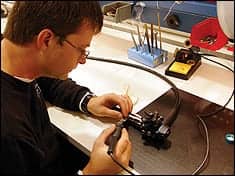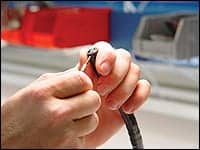Endoscopes are not cheap—not to buy or to repair. Unfortunately, they are also not the sturdiest of instruments. One slight mishap can result in serious and expensive damage.
“Endoscopes typically run between $15,000 and $30,000. If anyone handled them incorrectly, the damage could be worth several thousands of dollars,” says Joseph D. Giardina Jr, senior clinical biomedical equipment technician for Catholic Health Initiative (CHI) clinical engineering department at St Joseph Health Center in Warren, Ohio.
 |
| Photos courtesy of Matlock Endoscopic Repairs, Sales, and Service Inc. |
Consequently, many biomedical/clinical engineering departments look for ways to minimize damage and reduce the cost of repairs. Yet, because endoscopes are such intricate instruments, the effort can be challenging. Many clinical/biomedical engineering departments have found it cost- or time-prohibitive to perform repairs, and very few, if any, handle them entirely in-house. However, this does not mean that biomeds cannot improve the balance sheet in this area.
The first step is to get a handle on what is being spent. Giardina recommends that facilities determine the endoscopic cost per procedure. “For instance, if you spend $152,000 on scope service annually and do 10,000 procedures, then the cost is $15.20 per procedure,” explains Giardina, who recommends a result in the low teens. Higher numbers indicate room for improvement. This can be achieved in a number of ways, depending upon the resources available, and often include addressing inventory, user education, biomed staff and training, and service contracts.
Dodging Damage
The best way to avoid repair costs is to avoid damage. “Most of the problems with scopes occur because of handling issues,” Giardina says. One biomed estimates that calls regarding scopes can be cut in half with a user education program.
Depending on the facility, endoscopes can be handled by any number of staff, including nurses, physicians, cleaning techs, and biomeds. And though many scopes are broken during processing, they can suffer damage anywhere along the way. To identify these danger spots, biomeds should evaluate the entire process, working with the staff involved. “You go through the process and try not to point fingers at people,” Giardina says.
Instead, steps are identified for improvement and presented to the staff in general. For instance, during an early evaluation, Giardina noted that after scopes were cleaned, they were hung against a brick wall. The scope would smack against the wall, resulting in damage to the lenses and IC chip. “We bought new cabinets,” Giardina says, which solved the problem.
Geoffrey Smith, CBET, specialty II field service technician with Aurora Health Care clinical engineering in Milwaukee, notes similar problems can occur when scopes are placed on a flat, stainless steel surface. “If the technician puts the scope on a towel, you’re not putting it on a stainless steel surface, so you have less of a chance of damaging the distal tip or cracking the illumination lens,” Smith says.
Another common area for damage is placement within the cleaning device. More than one biomed has noted that distal tips can be smashed when the device door is closed if the scope is placed incorrectly. Pointing this out and suggesting how to lay the scope down to preserve its integrity can help to avoid this damage.
Manufacturer and third-party companies may provide some of this training.
Other biomed departments handle the training in-house, developing relationships with surgical and processing teams to foster open communication. Repeat sessions with both new and older staff inculcate these tips.
Many biomed departments have found user education can help to not only avoid damage, but also to facilitate communication about what is wrong with the scope. “Hey, it’s broken” can be too vague and not offer a starting point for repairs.
Troubleshooting Scopes
 |
| Scopes can suffer damage anywhere along the way. Distal tips, for example, can be smashed when the door of a cleaning device is closed if the scope is placed incorrectly. |
“Hey, it’s broken” can also be inaccurate. Having a relationship with the clinical staff can help to elicit more useful information. “We know the staff well enough to say, ‘Be a little more descriptive than broken,’ ” Smith says. A strong relationship can even result in confessions of mishandling, such as dropping the scope. “This gives me an idea of what to look for,” Smith says.
Sometimes the problem is not actually the scope. For instance, Smith recalls reports of blue haze in the image, which were the result of improper light balancing. “A lot of it is talking to the staff and thinking it through. Don’t always assume it’s the scope,” he says, noting there are different components of a scope and the process to consider.
Scope components include the control body, the insertion tube, the distal tip and bending section, and the light guide connector. Endoscopic procedures also involve camera processors, light sources, and monitors.
Common problems include tears in the bending rubber, kinks in cables or the air/water channel, and improper angulation. Leak tests can identify holes or tears and determine that a scope should not be processed to prevent fluid invasion, which results in much more expensive repair.
“Our staff is really well trained on doing leak tests during precleaning, and we don’t get a lot of fluid invasion,” Smith says.
To determine whether the scope is actually the problem, Giardina examines the entire device, first beginning with a top-to-bottom inspection using a magnifying glass followed by a feel check. He looks for debris, tears, chips, proper connections, wear and tear, scratches, nicks, peeling, bends, kinks, dents, improper knob movement, malfunctioning switches, and corrosion.
The procedure can identify whether there is anything (or nothing) wrong with the scope or whether there might be multiple problems. Catching the trouble early will prevent the issues from becoming more problematic later and enable everything to be fixed at once, particularly if the scope is sent out.
Similar checks can be run periodically as a preventive measure, as well as when scopes are returned from repair, which saves money over the long term. Smaller repairs can run $400 to $500, whereas damage from fluid invasion requires a complete overhaul costing $7,000 to $9,000, Giardina estimates.
Repairing In-house
Once it is determined that the scope is indeed the problem, repairs are initiated by whomever the facility employs: in-house biomeds, the manufacturer, or a third party.
At Opelousas Hospital in Opelousas, La, repairs have been handled in-house since 2004. “We only send out about 20% of our scopes now, and those are for major repairs,” says Tommy Lanclos, a biomed III at Opelousas.
Lanclos will adjust angulation, change bending rubbers, repair leaks, and fix issues associated with the air/water channel. He sends out repairs that involve the tubing. The work does not take up 100% of his day, but Lanclos acknowledges he does spend a lot of time on scopes. The effort, however, has been well worth it.
Opelousas’ supervisor of biomedical engineering, Kerry Keenam, notes the facility used to send out 100% of its scope repairs at the cost of about $1,000 per week. “Now, we’re spending about $30,000 to $40,000 a year on scope repair,” Keenam says, adding that during that time the endoscope caseload has quadrupled and the scope inventory has doubled. “So there’s tremendous savings potential that biomeds could be capturing if they get the proper training,” Keenam says.
The numbers estimated in a cost analysis prior to bringing endoscopic repair in-house was enough to justify the cost of training and tools to hospital administrators. “It came down to dollars and cents as most things do, and we were able to prove within a very, very short time that we were saving a lot of money and increasing workflow,” Keenam says.
“I think the biggest savings is in turnaround time. We’ve exceeded the surgical team’s expectations,” says Bryan Labbe, CBET, CRES, imaging specialist for Opelousas, adding that the surgical team’s support for the program was key to its implementation.
Lanclos notes that if a repair is expected to take under an hour, he will often do it immediately. More complex service can be done at more convenient times since the inventory (about 24 scopes) allows for backups. “But there are some doctors that prefer certain scopes, so I try to get those scopes up as soon as I can,” Lanclos says.
Lanclos—who received his education through Matlock Endoscopic Repair, a third-party company in Nashville, Tenn—cites training and tools as key to effectively servicing scopes.
Sending Scopes Out
For some biomed departments, scope repair costs can be prohibitive, particularly if the endoscope inventory is low. Yet even if minor repairs are brought in-house, as at Opelousas, more complicated fixes will have to be sent out.
“When you start talking about taking a scope apart, especially if you’re going to redo the insertion tube or even put a sheath on, then you start running into ISO certification,” Smith says. “That’s where you start getting into having to really document your inventory and the training that you’ve had.”
For these reasons, major repairs are sent out by nearly all biomedical/clinical engineering departments, either to the manufacturer or a third-party company. Many biomeds have developed strong opinions about the best way to go. Some feel third parties offer the best value; others feel manufacturer quality can’t be matched. Giardina falls into the latter category.
“I truly believe the manufacturer will do the highest-quality job at repairing the scopes,” Giardina says, citing their safety testing methods, parts’ quality, and expertise.
Manufacturer repair can help to ensure that the scopes match the specifications required for maximum performance. During a visit to Olympus, Giardina noticed that the bending rubber used on a specific scope was unique. “It’s wider at one end than the other, and some of the third-party companies don’t use the same piece,” Giardina says. He pointed it out to a third-party representative, who confirmed the discrepancy and corrected it.
Another part that needs to meet specifications is the insertion tube. “Some companies use different styles of insertion tubes, which are less rigid than the manufacturer’s. So it actually changes the flexibility of the scope altogether,” Giardina says.
However, Giardina also acknowledges that third parties can provide a valuable service and has used them in the past. Some biomeds have found them to provide repairs at less cost and with quicker turnaround.
Both manufacturers and third-party companies have the volume to develop the necessary expertise. “They might evaluate three scopes a day and repair three. Even if we serviced all three of our hospitals, we would not see that many scopes,” Giardina says.
In either case, biomeds should track scope repairs to be sure the problem has actually been solved. If a scope is sent out multiple times for the same repair, it could indicate poor service or old parts. “Some scopes are repaired too many times without replacing the innards, and because of that, they fail more frequently,” Giardina says.
|
Find endoscope parts and service help in the Buyer’s Guide. |
Smith notes that if a scope needed multiple repairs for the same problem, he would point it out to the service company and ask that the problem be rectified and credit given for the ineffective repairs. “Generally, we don’t run into that problem,” Smith says. Instead, he finds repairs are done well and quickly, with scopes typically returned within 48 hours.
One of the best ways he has found to maximize a relationship is through trust and friendship building, which he applies both to the hospital staff who use the equipment and the vendors who supply and service it. “You learn to respect each other, and you don’t always need to focus on the end result. If they want to talk about something non-equipment-related, let that go,” Smith advises.
Of course, this effort will, ideally, contribute to a positive end, one that results in more effective service. If biomeds can keep their endoscopic costs per procedure at a reasonable level, then they will have achieved this goal and scoped out their solution.
Renee Diiulio is a contributing writer for 24×7. For more information, contact .




